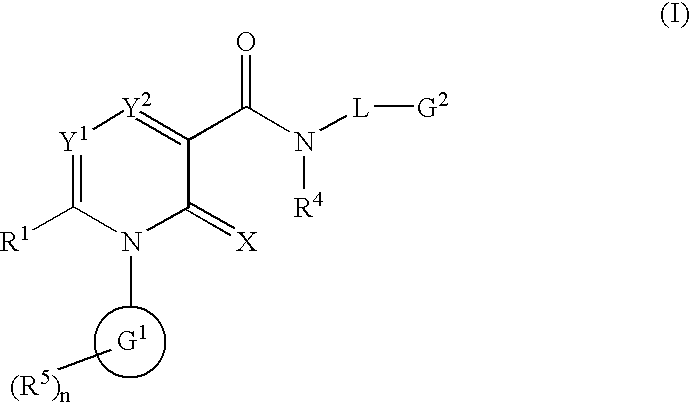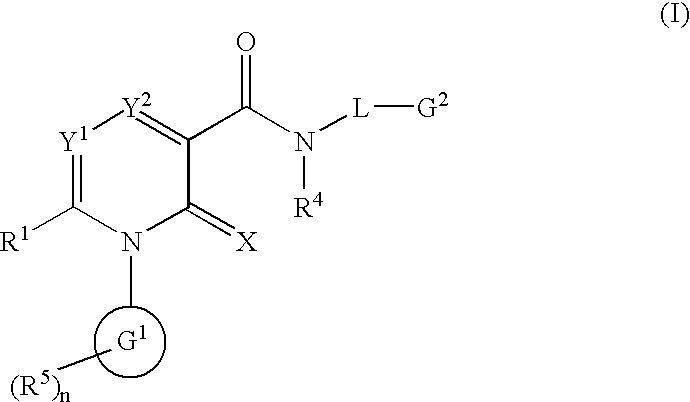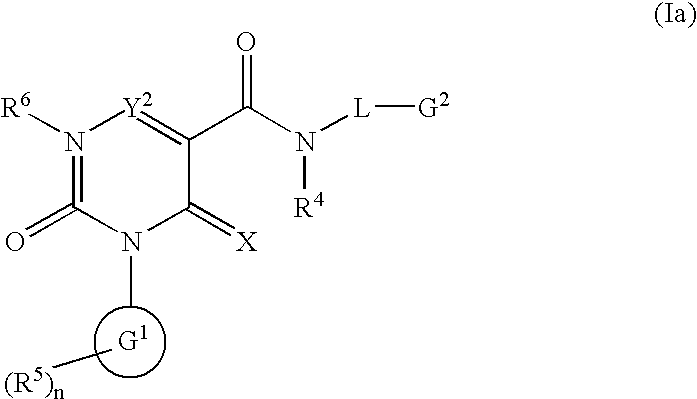2-Pyridone derivatives as inhibitors of neutrophile elastase
- Summary
- Abstract
- Description
- Claims
- Application Information
AI Technical Summary
Benefits of technology
Problems solved by technology
Method used
Image
Examples
example 1.1
6-Methyl-N-[4-(methylsulfonyl)benzyl]-2-oxo-1-[3-(trifluoromethyl)phenyl]-1,2-dihydropyridine-3-carboxamide
[0645]1H NMR (CDCl3): δ 9.96 (1H, t); 8.57 (1H, d); 7.85 (2H, d); 7.80 (1H, d); 7.73 (1H, t); 7.50 (3H, brd); 7.42 (1H, d); 6.46 (1H, d); 4.65 (2H, d); 3.00 (3H, s); 2.07 (3H, s).
example 1.2
6-Methyl-N-(4-morpholin-4-ylbenzyl)-2-oxo-1-[3-(trifluoromethyl)phenyl]-1,2-dihydropyridine-3-carboxamide
[0646]1H NMR (DMSO-d6): δ 9.69 (1H, brt); 8.38 (1H d); 7.89-7.87 (2H, m); 7.79 (1H, t); 7.70 (1H, d); 7.15 (2H, d); 6.87 (2H, d); 6.62 (1H, d); 4.36 (2H, d); 3.72-3.69 (4H, m) 3.05-3.03; (4H, m); 2.00 (3H, s).
[0647] APCI-MS m / z: 472 [MH+].
example 1.3
6-Methyl-N-[4-(methylsulfonyl)phenyl]-1,2-oxo-1-[3-(trifluoromethyl)phenyl]-1,2-dihydropyridine-3-carboxamide
[0648]1H NMR (CDCl3): δ 12.00 (1H, s); 8.66 (1H, d); 7.92-7.85 (5H, m); 7.79 (1H, t); 7.56 (1H, s); 7.49 (1H, d); 6.55 (1H, d); 3.04 (3H, s); 2.13 (3H, s).
[0649] APCI-MS m / z: 451[MH+].
PUM
| Property | Measurement | Unit |
|---|---|---|
| Molar density | aaaaa | aaaaa |
| Molar density | aaaaa | aaaaa |
| Molar density | aaaaa | aaaaa |
Abstract
Description
Claims
Application Information
 Login to View More
Login to View More - R&D
- Intellectual Property
- Life Sciences
- Materials
- Tech Scout
- Unparalleled Data Quality
- Higher Quality Content
- 60% Fewer Hallucinations
Browse by: Latest US Patents, China's latest patents, Technical Efficacy Thesaurus, Application Domain, Technology Topic, Popular Technical Reports.
© 2025 PatSnap. All rights reserved.Legal|Privacy policy|Modern Slavery Act Transparency Statement|Sitemap|About US| Contact US: help@patsnap.com



